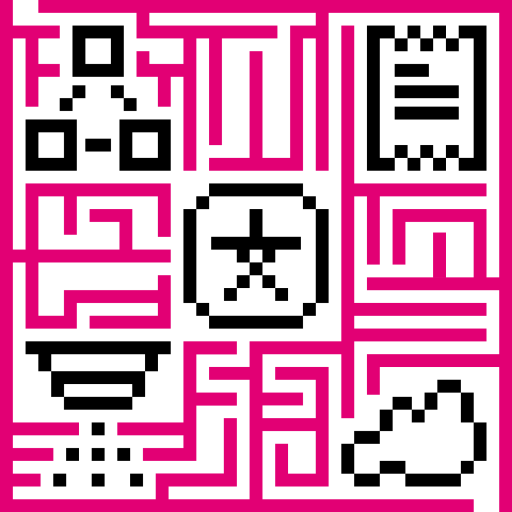In this tutorial, we will explain how to work with RPC call reply node and also how to:
- Create and connect different rule chains using rule chain node.
- Filter messages using filter script node.
- Transform incoming messages with transformation script node.
- Fetch latest telemetry data of related entities with related entity data node.
- Log messages with log node.
Intro
We have 2 devices - controller and thermostat. We want to initiate client-side RPC call from controller and request related thermostat current temperature value. RPC call will have 2 properties:
- method: getCurrentTemperature
- params: empty JSON object
Model definition
There is a room where 2 devices are installed: thermostat and controller.
- The thermostat is represented as Device with the name Thermostat A and type Thermostat.
- The controller is represented as Device with name Controller A and type Controller.
- Create relation from Controller A to Thermostat A via relation type Thermostat.
Configure Rule Chains
Create new Rule Chain: Related thermostat temperature
Go to Rule Chains -> Add new Rule Chain
Configuration:
- Name : Related thermostat temperature
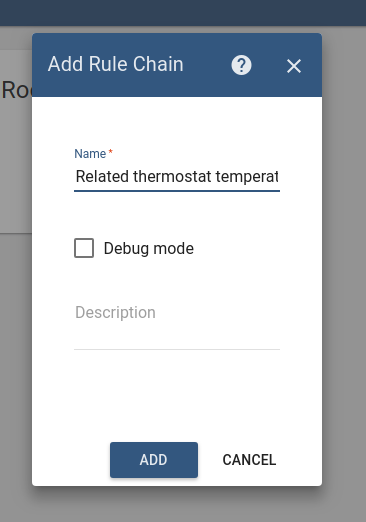
New Rule Chain is created. Press on the rule chain row to open it.
Add node: related entity data
Add related entity data node and connect it to the input node.
This node will fetch latest temperature reading of related thermostat Thermostat A and save it in message metadata with name roomTemperature.
Configuration:
- Name: Get temperature from related Thermostat
- Direction: From originator
- Max relation level: 1
- Relation type : Thermostat
- Entity type : Device
- Data to fetch: Latest telemetry
- Source attribute key: temperature
- Target key: roomTemperature


Add transformation node: script
Add transformation script node and connect it to the related entity data node.
This node will transform an original message into RPC reply message. RPC call reply node sends message payload as the response to the request, so we need to construct proper payload in transformation node.
Configuration:
- Name: Build response
- ScriptLang: TBEL
- Script:
1
return {msg: {"temperature": metadata.roomTemperature}, metadata: metadata, msgType: msgType};

Add action node: RPC call reply
RPC call reply node takes RPC requestId from message metadata. This id used to identify incoming RPC call.
This node takes message payload and sends it as the response to the message originator.
Configuration:
- Name : Send response
- Request ID : requestId

This rule chain is ready and we should save it. Here is how Related thermostat temperature rule chain should look like:

Connect Rule Chains
Now we will connect our new chain with the Root Rule Chain. We want to route incoming RPC requests with method property equals to getCurrentTemperature to our new rule chain Related thermostat temperature. Let’s return to the list of rule chains and open our Root Rule Chain to make required changes.
Add filter node: script
Add filter script node and connect it to the default message type switch node with relation type RPC Request from Device. Default Root Rule Chain should already have such node connection from message type switch node to the log node with name “Log RPC from Device”. In such case we need to replace log node Log RPC from Device with newly created script node. Please don’t remove log node. We will reuse it for logging uknown RPC requests.
Configuration:
- Name: Filter getCurrentTemperature RPC
- ScriptLang: TBEL
- Script:
1
return msg.method == "getCurrentTemperature";

After this, all incoming messages with message type RPC Request from Device will be routed to this node. Inside this node, function will filter only allowed RPC requests with method == getCurrentTemperature
Add node: rule chain
Add rule chain node with True node connection to the previous filter script node “Filter getCurrentTemperature RPC”.
Configuration:
- Name: To Related thermostat temperature
- Rule Chain: Related thermostat temperature
- Forward message to the originator’s default rule chain: Disabled
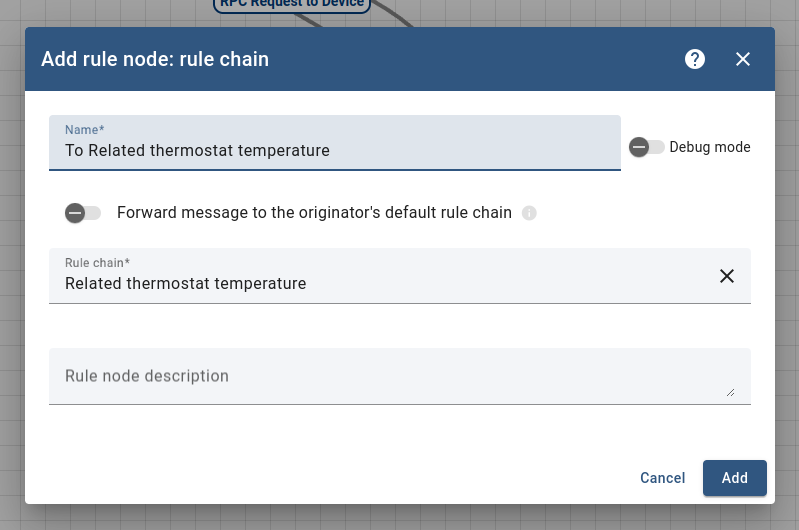
Now, all messages that satisfy configured filter will be routed to Related thermostat temperature Rule Chain
Log unknown request
Reconnect the filter script node “Filter getCurrentTemperature RPC” with node connection False to the previously disconnected log node. All incoming RPC requests with method that doesn’t equal to the “getCurrentTemperature” will be passed from filter script to the log node.
Configuration:
- Name: Log RPC from Device
- ScriptLang: TBEL
- Script:
1
return '\nIncoming message:\n' + JSON.stringify(msg) + '\nIncoming metadata:\n' + JSON.stringify(metadata);
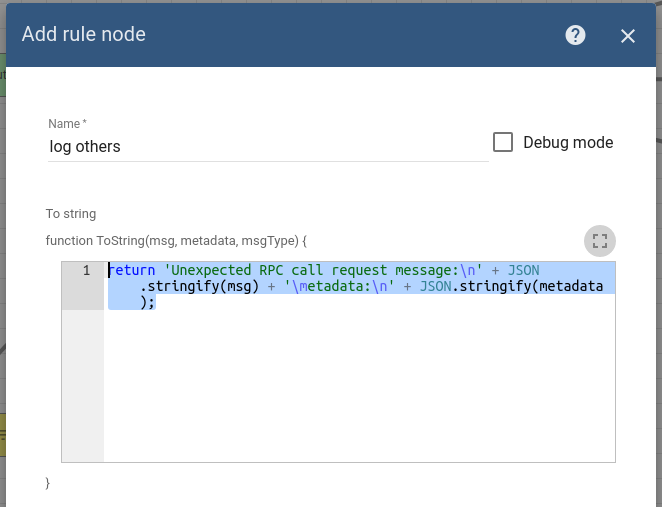
Changes in the Root Rule Chain are finished and we should save it. Here is how Root Rule Chain should look like:
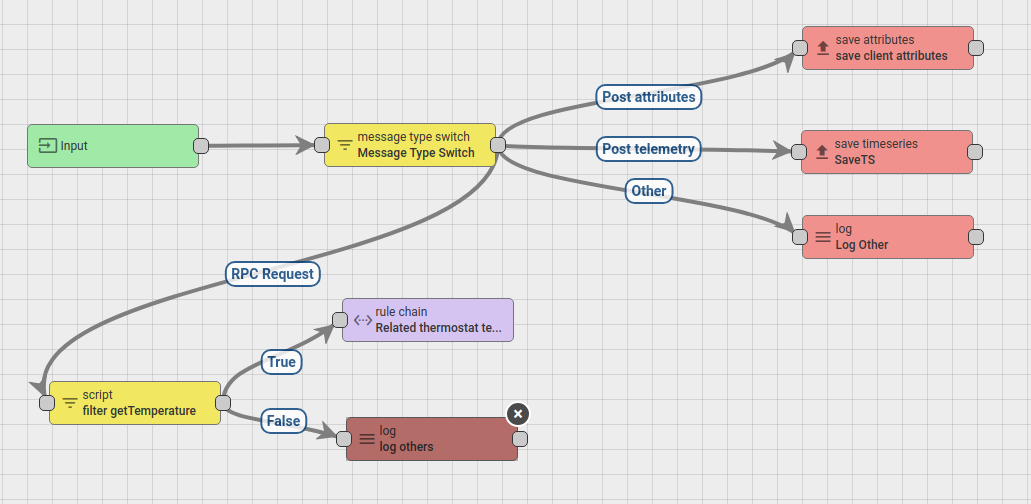
Verify configuration
Configuration is finished and we can verify that Rule Chains work as expected.
Let’s start with publishing “temperature” telemetry for Thermostat A device. For sending HTTP request, we will use curl utility.
- To trigger telemetry upload let’s go to Check connectivity tab of the device page and copy curl command to publish telemetry for our thermostat device.

- Execute the copied command:
1
curl -v -X POST http://iothub.magenta.at/api/v1/CF8zr16VZeCk7zRyztZB/telemetry --header Content-Type:application/json --data "{temperature:25}"
We will use REST RPC API for emulating Controller A device RPC requests from device to server.
For triggering RPC request, we need to do the same action for device Controller A as for the Thermostat A device, namely copy the curl command from the Check connectivity tab. After that let’s make a few changes to the command to trigger REST RPC API:
- Change the API path by replacing telemetry with rpc
- Change the payload from
{temperature:25}to{method: "getCurrentTemperature", params:{}}
The resulted command should look like:
1
curl -v -X POST http://iothub.magenta.at/api/v1/ZcHBHbptBqxgV1A6Qrtx/rpc --header Content-Type:application/json --data "{method: "getCurrentTemperature", params:{}}"
Response:
1
{"temperature":"25"}
It is expected result. Controller A sends RPC call to the IoT Hub with method getCurrentTemperature. Message was routed via configured rule chain and latest telemetry of the related thermostat were fetched and returned in the response.
If we try to submit request with unknown method:
1
curl -v -X POST http://iothub.magenta.at/api/v1/ZcHBHbptBqxgV1A6Qrtx/rpc --header Content-Type:application/json --data "{method: "getCurrentHumidity", params:{}}"
we will see message in the IoT Hub log file:
[rule-dispatcher-0-3] INFO o.t.rule.engine.action.TbLogNode -
Incoming message:
{"method":"getCurrentHumidity","params":{}}
Incoming metadata:
{"deviceType":"Controller","requestId":"1","sessionId":"54c2abd1-6496-4ab3-9036-e044083b1823","serviceId":"tb-core-1","deviceName":"Controller A"}
For more details how RPC works in the IoT Hub, please read RPC capabilities Article.
